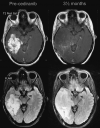Pseudoprogression and pseudoresponse: imaging challenges in the assessment of posttreatment glioma
- PMID: 21393407
- PMCID: PMC7964401
- DOI: 10.3174/ajnr.A2397
Pseudoprogression and pseudoresponse: imaging challenges in the assessment of posttreatment glioma
Abstract
The current standard of care for newly diagnosed cases of high-grade glioma is surgical resection followed by RT with concurrent chemotherapy. The most widely used criteria for assessing treatment response are based on a 2D measurement of the enhancing area on MR imaging known as the Macdonald Criteria. Recently, nontumoral increases (pseudoprogression) and decreases (pseudoresponse) in enhancement have been found, and these can confuse outcome evaluation. Here we review pseudoprogression and pseudoresponse and describe how better understanding of these phenomena can aid interpretation.
Figures





References
-
- Stupp R, Mason WP, van den Bent MJ, et al. . Radiotheraphy plus concomitant and adjuvant temozolomide for glioblastoma. N Engl J Med 2005;352:987–96 - PubMed
-
- Macdonald DR, Cascino T, Schold SJ, et al. . Response criteria for phase II studies of supratentorial malignant glioma. J Clin Oncol 1990;8:1277–80 - PubMed
-
- Wen PY, Macdonald DR, Reardon DA, et al. . Updated response assessment criteria for high-grade gliomas: response assessment in neuro-oncology working group. J Clin Oncol 2010;28:1963–72 - PubMed
-
- Brandsma D, van den Bent MJ. Pseudoprogression and pseudoresponse in the treatment of gliomas. Curr Opin Neurol 2009;22:633–38 - PubMed
Publication types
MeSH terms
LinkOut - more resources
Full Text Sources
Medical
